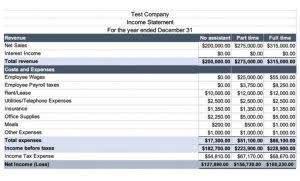What Is the LIFO Method? Last-in, First-out Explained

For example, those companies that sell goods that frequently increase in price might use LIFO to achieve a reduction in taxes owed. When inventory is artificially inflated, COGS will be under-reported which, in turn, will lead to a higher-than-actual gross profit margin, and hence, an inflated net income. Accountants use “inventoriable costs” to define all expenses required to obtain inventory and prepare the items for sale. For retailers and wholesalers, the largest inventoriable cost is the purchase cost. LIFO is more difficult to account for because the newest units purchased are constantly changing. However, if there are five purchases, the first units sold are at $58.25.

Try QuickBooks Accounting Software for Small Businesses Free for 30 Days
In total, the cost of the widgets under the LIFO method is $1,200, or five at $200 and two at $100. If a company uses a LIFO valuation when it files taxes, it must also use LIFO when it reports financial results to its shareholders, which lowers its net income. Last in, first out (LIFO) is only used in the United States where any of the three inventory-costing methods can be used under generally accepted accounting principles (GAAP). The International Financial Reporting Standards (IFRS), which is used in most countries, forbids the use of the LIFO method. This method of inventory valuation is widely used as it is simple to use. Also, it is difficult to manipulate net income under this inventory pricing method.
- The LIFO method assumes that Brad is selling off his most recent inventory first.
- When inventory is acquired and when it’s sold have different impacts on inventory value.
- By using this method, you’ll assume the most recently produced or purchased items were sold first, resulting in higher costs and lower profits, all while reducing your tax liability.
- The 450 books are now no longer considered inventory, they are considered cost of goods sold.
To Ensure One Vote Per Person, Please Include the Following Info
Assuming that demand will remain constant, it only purchases 500,000 units in year four at $15 per unit. Cost of goods sold is the direct cost of producing a good, which includes the cost of the materials and labor used to create the good. COGS directly impacts a company’s profits as COGS is subtracted from revenue. If a company can reduce its COGS through better deals with suppliers or through more efficiency in the production process, it can be more profitable. The first in, first out (FIFO) cost method assumes that the oldest inventory items are sold first, while the last in, first out method (LIFO) states that the newest items are sold first.
Why Is LIFO Accounting Banned in Most of the World?
You will need to strategically find ways to reduce your costs so that you can improve your profitability. Selling, general, and administrative (SG&A) expenses are usually put under this category as a separate line item. You also have to spend $1 per bath soap on the labor required to craft it and $1 for packaging.
What Types of Companies Often Use FIFO?

Therefore, the ending inventory and cost of goods sold would be different as against the periodic inventory system. Thus, total purchases at the end of the accounting period are added to the opening inventory to calculate the cost of goods available for sale. Then, in order to calculate COGS, the ending inventory is subtracted from the cost of goods available for sale so calculated. Using FIFO does not necessarily mean that all the oldest inventory has been sold first—rather, it’s used as an assumption for calculation purposes. Learn more about what FIFO is and how it’s used to decide which inventory valuation methods are the right fit for your business.


COGS is an important metric on financial statements as it is subtracted from a company’s revenues to determine its gross profit. Gross profit is a profitability measure that evaluates how efficient a company is in managing its labor and supplies in the production process. The Sterling example computes inventory valuation for a retailer, and this accounting process also applies to manufacturers and wholesalers (distributors). The costs included for manufacturers, however, are different from the costs for retailers and wholesalers.
- However, the way of computation may differ if you’re using the periodic inventory vs perpetual inventory system.
- If LIFO affects COGS and makes it more significant during inflationary times, we will have a reduced net income margin.
- FIFO assumes that cheaper items are sold first, generating a higher profit than LIFO.
- No, the LIFO inventory method is not permitted under International Financial Reporting Standards (IFRS).
- You can save all this time to calculate manually, though, if you are using online accounting software like Deskera.
- The LIFO method is used in the COGS (Cost of Goods Sold) calculation when the costs of producing a product or acquiring inventory has been increasing.
- When all of the units in goods available are sold, the total cost of goods sold is the same, using any inventory valuation method.
- Whereas, the closing inventory is the unsold inventory at the end of the current financial year.
- Let’s assume that a sporting goods store begins the month of April with 50 baseball gloves in inventory and purchases an additional 200 gloves.
- Instead, they have what is called “cost of services,” which does not count towards a COGS deduction.
- However, the main reason for discontinuing the use of LIFO under IFRS and ASPE is the use of outdated information on the balance sheet.
- Businesses thus try to keep their COGS low so that net profits will be higher.
Breaking down your COGS calculation into smaller parts is a smart way to ensure that your costs and inventory accounted are accurate. As stated, one of the benefits of the LIFO reserve is to allow investors and analysts to compare companies that use different accounting methods, equally. The most important benefit is that it allows a comparison between LIFO and FIFO and the ability to understand any differences, including how taxes might be impacted. Deskera’s lifo cogs formula inventory management software updates your stocks in real-time and allows you to view the stock availability in each warehouse in seconds. Knowing and using the formula makes it easy for you to get the correct cost numbers without doing a manual calculation for each item purchased. While the LIFO inventory valuation method is accepted in the United States, it is considered controversial and prohibited by the International Financial Reporting Standards (IFRS).
- Under LIFO, Company A sells the $240 vacuums first, followed by the $220 vacuums then the $200 vacuums.
- Therefore, the balance sheet may contain outdated costs that are not relevant to users of financial statements.
- Even if a company produces only one product, that product will have different cost values depending upon when they produce it.
- Throughout Year 1, the retailer purchases $10 million in additional inventory and fails to sell $5 million in inventory.
- In periods of rising prices, constant increases in costs can create a credit balance in the LIFO reserve, which results in reduced inventory costs when reported on the balance sheet.
- Higher reported gross income also leads to an inflated representation of profits.
Again, these are short-term differences that are eliminated when all of the shirts are sold. Learn more about the difference between LIFO vs FIFO inventory valuation methods. This includes direct labor cost, direct material cost, and direct factory overheads.
